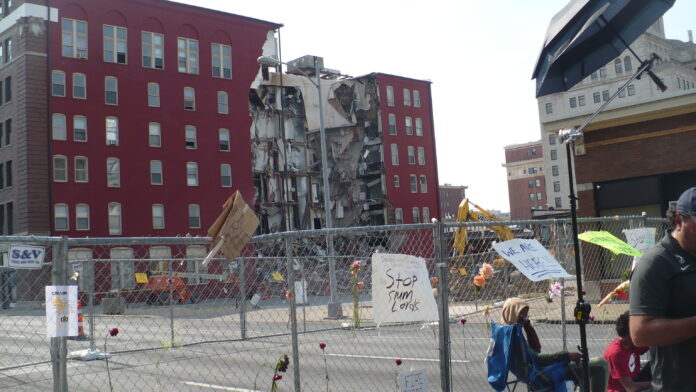
The partial collapse – and eventual demolition – of the apartment building at 324 Main St., Davenport, has spurred questions over the causes of the disaster.
Now, some of the answers are coming into focus. And some of those causes are focused on “grossly inadequate” shoring on one of the building’s walls, poor building maintenance and poor oversight of repair work, according to a new report on the building collapse.

A “Causes and Origins” preliminary investigation report was released by the City of Davenport on Thursday, Sept. 7. (That complete report can be found here.)
The report’s findings come after a months-long investigation by SOCOTEC Engineering and White Birch Group LLC, the same consultant that responded to the Surfside, Florida, condominiums collapse in 2021, according to information released by the city.
One of the first items outlined in the report is what it calls the “grossly inadequate” temporary shoring of the building’s west wall. “Had a proper shoring and construction phasing plan been implemented during these repairs, the building would not have partially collapsed on May 28, 2023,” according to the report.
“Based on the photographic evidence of pre-collapse condition, in addition to on-site observations after the incident, it is apparent that building ownership/management did not adequately address exterior (and other) maintenance requirements, thereby resulting in the compromised integrity of the west elevation wall,” the report states.
The document also blames agencies and people responsible for inspecting and overseeing work on the building for the partial collapse: “This lack of professional oversight allowed the work by the most recent repair contractor to proceed in an unsafe, incomplete, and improper manner,” the report added.
The report’s summary of the engineering investigation was based on available on-site observations and documentation, evaluation of electronic documents produced, and communications with city officials. “The City of Davenport engaged White Birch Group, LLC (WBG) and SOCOTEC Engineering, Inc. (SEI) to investigate and provide opinions regarding the cause and origin of the collapse,” according to the report.
Some of the findings in the 113-page report state the partial collapse was caused by:
- Inadequate capacity of wall system: “The removal of multiple wythes of masonry during the repair work in the three days preceding the collapse severely compromised the western bearing wall and caused it as well as the areas it supported to collapse on May 28, 2023. The temporary shoring that had been installed was grossly inadequate. Had a proper shoring and construction phasing plan been implemented during these repairs, the building would not have partially collapsed on May 28, 2023.”
- Inadequate shoring: “The temporary stabilization methods specified by the design professionals during various repair projects for the building do not appear to have considered that the western wall served as a critical structural load bearing element. Additionally, the shoring implemented by the most recent masonry repair contractor at the subject building does not conform to usual and customary practices for masonry wall shoring or stabilization.”
- Improper understanding of original building construction: The engineers and masonry contractors responsible for repairs to the building repeatedly misidentified the structural bearing wall as a nonstructural system. As such, they underestimated the significance of the observable signs of distress in the wall, delayed necessary repair work, designed and installed a weaker replacement system, and removed significant portions of the wall without first installing adequate temporary shoring.”
- Inadequate construction documents: The available construction documents for repair work conducted between 2020 and 2023 do not provide adequate details and specifications for a contractor to implement the repair work necessary at the subject building. This resulted in the implementation of many incomplete and inadequate repairs. Furthermore, this lack of documentation limited the city inspectors’ ability to easily verify that the work being performed was consistent with the engineer’s intent.”
- Neglect of composite wall: “The design professionals and masonry repair contractors replaced portions of the original … thick bearing wall with a substantially weaker non-composite cavity wall system.”
- Inadequate oversight of repairs: The deficiencies with the design and implementation of repairs noted herein were exacerbated by the lack of on-site presence by a qualified design professional during the repair work. This lack of professional oversight allowed the work by the most recent repair contractor to proceed in an unsafe, incomplete, and improper manner.”
- Inadequate repair techniques: “The improperly repaired brick masonry wall sections were poorly integrated with the original construction and increased the inherent weakness of the west elevation wall.”
- Inadequate frequency and type of maintenance: “The subject building exhibited many signs of improper and inadequate exterior envelope maintenance, resulting in excessive water infiltration. Improperly maintained composite clay brick masonry walls will degrade over time due to water infiltration and the effects thereof, resulting in a structurally weakened wall system. Based on the photographic evidence of pre-collapse condition, in addition to on-site observations after the incident, it is apparent that building ownership/management did not adequately address exterior (and other) maintenance requirements, thereby resulting in the compromised integrity of the west elevation wall.”
The apartment building, known as The Davenport, partially collapsed on May 28. Three apartment residents died in the incident: Branden Colvin Sr., 42; Ryan Hitchcock, 51; and Daniel Prien, 60.
“Since the day of the partial collapse at 324 Main Street, we have been laser-focused on identifying the causes of this tragic incident,” Davenport Mayor Mike Matson said in a news release Thursday. “We engaged the services of the consultants who responded to the Surfside condominiums collapse (in Florida) in 2021, and we promised the public we would share their findings. Today, we are following through on that promise. Our hearts and thoughts remain with the families of Ryan, Branden, and Daniel and their loved ones, friends and neighbors.”
City of Davenport officials did not respond to requests by the QCBJ for further comments Thursday morning.




